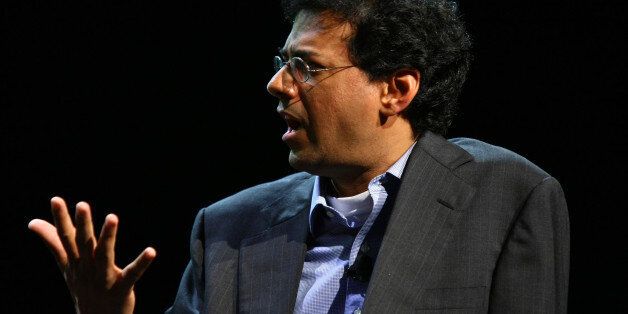
Whether you call it “assisted suicide” or “death with dignity,” stories about people choosing to die on their own terms have been making the news.
Take Brittany Maynard for example, the 29-year-old who moved to Oregon -- one of the few states where legal, physician-assisted suicide is available to the terminally ill -- where she ended her battle with brain cancer this weekend. Or take Ezekiel J. Emmanuel, a man in his fifties in reasonably good health who nonetheless says he hopes to to die by 75.
Emmanuel insists he isn’t “talking about waking up one morning 18 years from now and ending my life through euthanasia or suicide,” both of which he more or less opposes; he’s hoping to die by that age to avoid years of discomfort, when he imagines he will no longer feel his life to be worth living.
Right now, there is no prominent mind suggesting that adults should have the right to choose whether or not to be alive. (The Supreme Court ruled that the Constitution doesn’t guarantee a right to suicide, in 1997.) If you are looking for a powerful voice to take up Maynard's mantle and argue for legal assisted suicide, Dr. Atul Gawande's Being Mortal may not be the book for you.
It's not that Gawande lands on the other side of the debate, with the stalwarts who believe human beings shouldn't tamper with their fate, even in the case of extreme pain. Rather, the surgeon and frequent contributor to The New Yorker falls somewhere in the middle, with a sort of non-stance on the issues that have surfaced once again in the conversation about end-of-life care.
Instead, Gawande presents a detailed, but highly readable history of how the meaning of death has changed over the past fifty or sixty years. He presents this history in the careful voice of a medical professional, but textured with the stories of older people he's met through his family and his practice.
His grandfather, who aged and died in India, plays a prominent role, as does his wife's grandmother, Alice, and a handful of his patients. All of them confront the same issues -- descent into fragility, a first fall, new dependence on family, choosing a nursing home -- and through them, what could be a sociology text becomes a sympathetic story about a time many of us will reach someday that seems frightening, but also holds the potential for feeling fulfilled.
These stories within the story help Gawande drive home the crucial point at the center of his book: that throughout the developed world, our approach to death has completely changed in just a few generations. And with that change come a host of new questions.
***
Gawande’s grandfather, a farmer in a village 300 miles outside Mumbai, India, had what the surgeon calls an “idyllic,” “premodern” experience of aging. Even when he became frail to the point where nowadays, Americans would put him in a nursing home, his relatives didn’t prevent him from going out by himself or doing anything that he wanted to do. When (and if) he returned home, they’d dutifully tend to him. Family was simply expected to care for an elder.
Importantly, this grandfather also had “three wives, all of whom he outlived,” and 13 children. Without them, his high-quality old age would not have been possible.
Several centuries ago, the elderly in Europe enjoyed similar treatment. “Children typically left home as soon as they were old enough to start families of their own,” Gawande writes. “But one child usually remained, often the youngest daughter.”
Providing in-home care to parents and grandparents usually wasn’t –- and isn’t, where it persists –- a responsibility spread evenly across the family. Young women are often charged with the old and the sick, even if these duties prevent them from having families or choosing occupations of their own. The “idyllic” situation isn’t really so idyllic for everyone, probably even in the case of the grandfather.
Gawande acknowledges that moving the elderly out of the multi-generational household is a victory –- not only for the nuclear family, which lacks the time, the money, and the desire to keep aging relatives at home, but also for older folks. As it turns out, financially secure seniors prefer not to live with their children.
But it’s also no accident that the move to the nursing home coincided with the 50- or 60-year period of women’s liberation. Being Mortal touches on this co-occurrence only briefly. To be rid of the elderly was a needed precondition for work outside the home: a huge triumph for women.
***
The rise of the nursing home ushered in a brave new world for older people and their families. In order to be attractive to elders, the facilities designed for them had to be positive places with minimal death-talk. Instead, facilities and hospitals began treating dying like an illness that could be cured. Gawande writes that in today’s climate, patients and doctors insist on optimism to a degree where they would rather risk dangerous surgery than buckle down for a tough conversation.
“Old age is not a diagnosis," he argues. We've reached a "new normal" where people are so afraid to talk about death that they agree to interventions that shorten or ruin a patient's remaining time.
They also incur high costs to the public health system. Currently, nearly thirty percent of Medicare dollars are spent on patients in their last six months of life, so that 5 percent of Americans account for half of public health expenditure. Gawande observes that if the elderly had to pay these costs out of pocket, that would change the cost-benefit equation for families and probably reduce the number of adults choosing to undergo major surgeries in their last year.
Rather than tell patients when they should stop trying to be cured or weigh in on "death with dignity," Gawande focuses on the question of how to make older people's remaining time feel meaningful.
People make different choices depending on how much time they think they have left, he writes. Planning ahead for a long future, younger people often seek out new relationships and ideas. But what makes life worth living for older people, especially once they can’t take care of themselves?
In Being Mortal, Gawande is surprised when one of his patients, a professor considered to be a serious intellectual, tells the surgeon he wants to live as long as he can watch football and eat chocolate ice cream. For some, small pleasures are enough of a raison d'être. For others, the answer isn't so simple. Gawande doesn't even address the contingent of people who would rather not experience the decline and loss of independence that come with aging.
Gawande makes several recommendations about how to make the last years meaningful for the people who are approaching death. Choice and responsibility, he argues, underlie how people find meaning in their last years. He traces the history of assisted living, and the first assisted-living facility where inmates could choose to smoke or eat candy. Something like that could work, within reason, he writes. Homes where inmates are given charge of a pet bird or a plant -- also good.
However, Gawande never seems to question his assumption that meaning is something to be given and taken away, something that can be tinkered into existence through small interventions and changes in policy. Certainly this is true to a point; in studies he cites in his book, nursing-home inmates report being happier when they have an animal to feed or a plant to water. But he doesn't consider that for some sick people, once strength and independence go, no trick could make them feel fulfilled.
Gawande's "ideal" is for patients to live lives that are long and comfortable, until they end, painlessly. He believes that this scenario is achievable through the use of medicine we have already, without legalizing physician-assisted suicide -- a term buried 250 pages into the book.
“What I think [of her decision to have assisted suicide] is that our health system has failed Brittany Maynard,” Gawande said in a HuffPost Live interview earlier this month. "She can't count on the idea that, as her symptoms progress, that she would be prevented from having suffering … that her priorities will be met."
Why should she have to count on medicine, if she preferred to count on herself? That is the question Being Mortal won't answer.
